Shaw, John Duncan (Captain)
Killed in Flying Accident 1977-March-04


Birth Date: 1944-July-28
Born: Arnprior, Ontario
Parents: Son of Duncan Oliver and Marjorie Edith (nee Tripp). Brother of Captain David Shaw and Douglas Shaw.
Spouse: Husband of Donna Rebecca (nee Riddell) Shaw of Baden-Baden, Federal Republic of Germany.
Home: Arnprior, Ontario
Enlistment: Kingston, Ontario
Enlistment Date: 1963-September-05
Decorations: CD
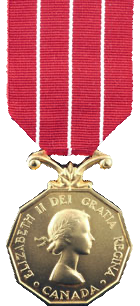
Service
RCAF
Unit
421 Sqn- Squadron
Bellicum Cecinere They have sounded the war trumpet
Base
Rank
Captain
Position
Pilot
Service Numbers
99859
Home
Starfighter serial: 12656

One of the most revolutionary military aircraft ever produced, the F-104 Starfighter was designed by Kelly Johnson and his team in 1952, at Lockheed's legendary "skunk works" in Burbank, California. The USAF ordered two prototypes in early 1953 and the XF-104 first flew in February 1954. Records established by the F-104 Starfighter are impressive: world altitude & speed records of 91,240 feet and 1,404 mph respectively in May 1958, world altitude record raised to 103,395 feet in December 1958 and unofficial world altitude record of 120,800 feet in December 1963.
******The Canadair CF-104 Starfighter (CF-111, CL-90) is a modified version of the Lockheed F-104 Starfighter supersonic fighter aircraft built in Canada by Canadair under licence. It was primarily used as a ground attack aircraft, despite being designed as an interceptor. It served with the Royal Canadian Air Force (RCAF) and later the Canadian Armed Forces (CAF) until it was replaced by the McDonnell Douglas CF-18 Hornet.
Canadair's internal designation was CL-90 while the RCAF's version was initially designated CF-111, then changed to CF-104. Although basically similar to the F-104G, the CF-104 was optimized for the nuclear strike/reconnaissance role, fitted with R-24A NASARR equipment dedicated to the air-to-ground mode only as well as having provision for a ventral reconnaissance pod equipped with four Vinten cameras. Other differences included retaining the removable refuelling probe, initial deletion of the fuselage-mounted 20 mm (.79 in) M61A1 cannon (replaced by an additional fuel cell) and the main undercarriage members being fitted with longer-stroke liquid springs and larger tires.
The CF-104 entered Canadian service in March 1962. Originally designed as a supersonic interceptor aircraft, it was used primarily for low-level strike and reconnaissance by the RCAF. Eight CF-104 squadrons were originally stationed in Europe as part of Canada's NATO commitment. Wikipedia
![]() Wikipedia Canadair CF-104 Starfighter
Wikipedia Canadair CF-104 Starfighter
![]() YouTube Canadair CF-104 Starfighter
YouTube Canadair CF-104 Starfighter
The Starfighter on display outside the Canadian Warplane Heritage Museum is a CF-104D, a two seat trainer version. The aircraft was acquired from the Department of National Defence in late 1995.
Unit Desciption
421 Sqn Bellicum Cecinere ("Red Indian")
History of the Squadron during World War II (Aircraft: Spitfire VA, VB, IX, IXB, XVI)
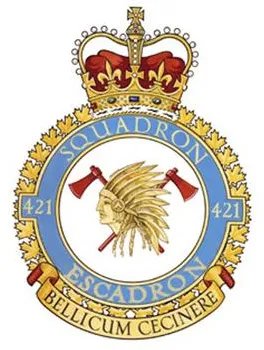
The squadron was the 20th squadron and the last of the eight Fighter squadrons formed overseas by the RCAF in WWII. It was initiated at Digby, Lincolnshire, England ![]() on April 9, 1942, It flew on defensive operations over Britain, as well as offensive operations over Europe, before D-Day. After the invasion, the squadron moved to France on 16 June 1944 and thereafter provided air and ground support to the Allied ground forces as they moved through France, the Low Countries and Germany. The squadron was disbanded at Utersen, Germany
on April 9, 1942, It flew on defensive operations over Britain, as well as offensive operations over Europe, before D-Day. After the invasion, the squadron moved to France on 16 June 1944 and thereafter provided air and ground support to the Allied ground forces as they moved through France, the Low Countries and Germany. The squadron was disbanded at Utersen, Germany ![]() on July 10, 1945.
on July 10, 1945.
In the course of its operations, the squadron flew some 10,900 sorties and claimed 79 enemy aircraft destroyed, 2 probables and 27 damaged, for the loss of 34 aircraft and 33 pilots, of whom 4 were killed, 25 missing and 4 injured. The squadron had 2 aces, Squadron Leader R.W McNair, DFC and 2 Bars, and Flight Lieutenant P.G. Johnson. The squadron members were awarded 1 second Bar to DFC, 2 Bars to DFC and 5 DFCs. Battle Honours were: Defence of Britain 1942-43, Fortress Europe 1942-44, France and Germany 1944-45, Normandy 1944, Arnhem, RhineWikipedia, Kostenuk and Griffin
Maps for Movements of 421 Squadron 1942-45

MAP 1: 421 Squadron Movements in England 1942-44 (right-click on image to display enlarged in new tab)
|
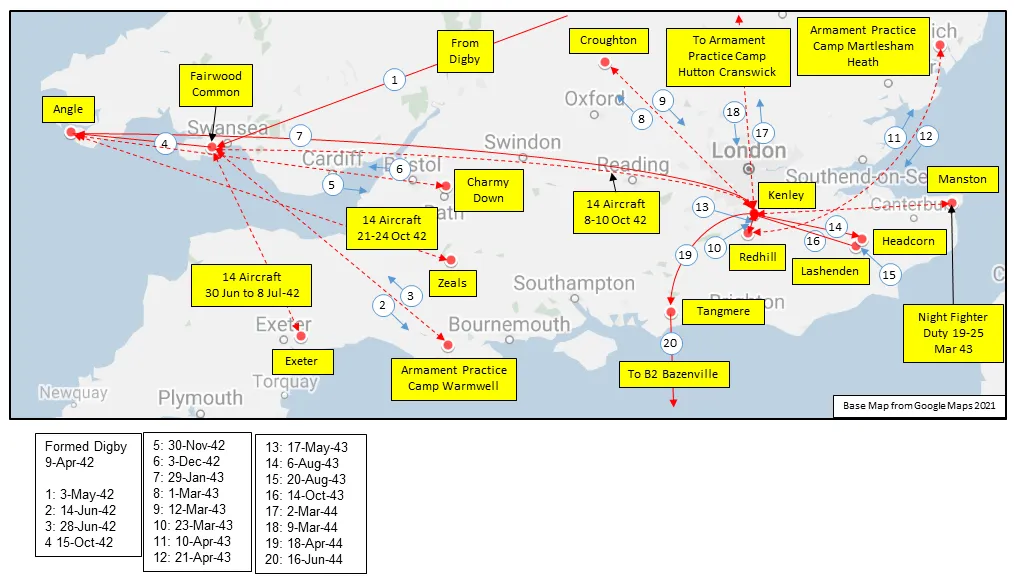
MAP 2: 421 Squadron Movements, detail of Map 1
|
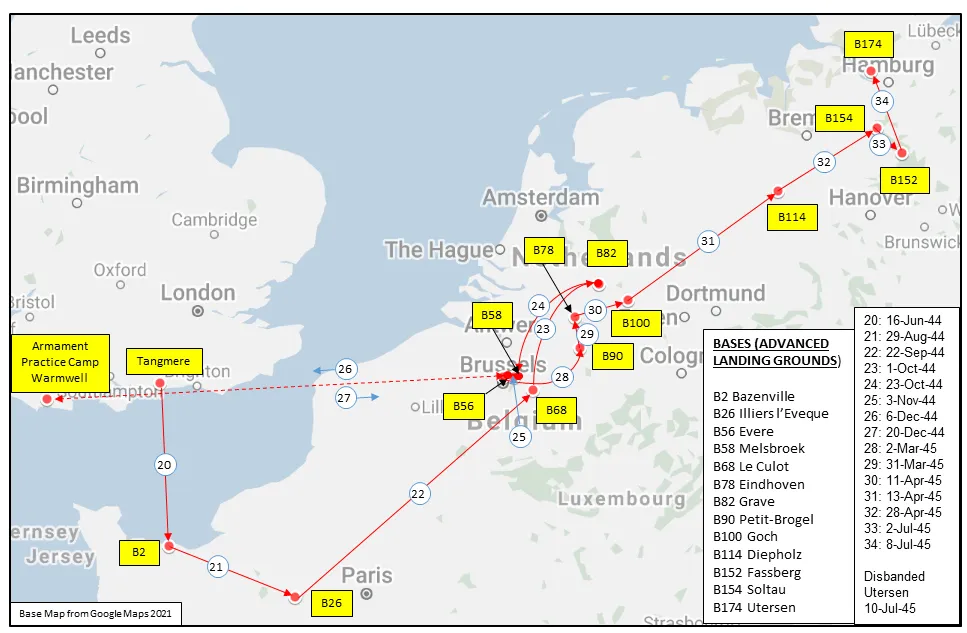
421 Squadron History Summary 1942-45
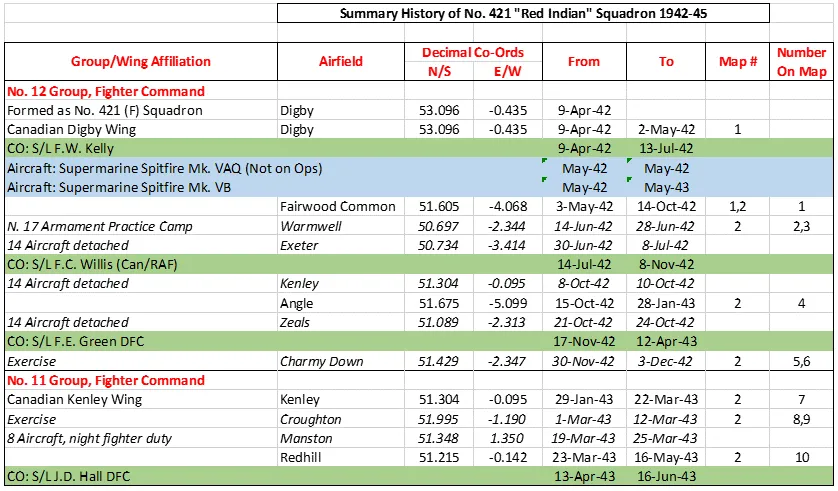
421Squadron History Summary 1942-45 Page 2
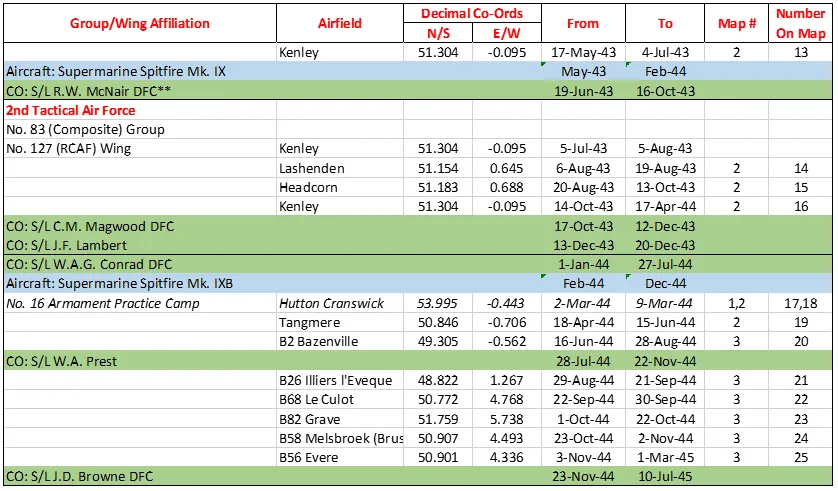
421 Squadron History Summary 1942-45 Page 3

History of the Squadron Post-WWII (Aircraft: Vampire III, 5, Meteor T7, Sabre 2, 5, 6, Starfighter)
The squadron was re-formed as a Fighter unit at Chatham, New Brunswick ![]() on 15 September 1949, flying de Havilland Vampire III aircraft and, during 1951, was stationed in the United Kingdom for operational training with the Royal Air Force, flying Gloster Meteor T Mk. 7 training aircraft. In December 1951 it was re-equipped with Sabre aircraft and in October 1952 joined No. 2 (Fighter) Wing at Grostenquin, France
on 15 September 1949, flying de Havilland Vampire III aircraft and, during 1951, was stationed in the United Kingdom for operational training with the Royal Air Force, flying Gloster Meteor T Mk. 7 training aircraft. In December 1951 it was re-equipped with Sabre aircraft and in October 1952 joined No. 2 (Fighter) Wing at Grostenquin, France ![]() . Selected as one of eight Sabre squadrons in No. 1 Air Division Europe to be re-equipped with CF-104 Starfighter aircraft for a nuclear strike role, the squadron was deactivated on 1 August 1963 and was reactivated as Strike Attack on 21 December. When No. 2 Wing was disbanded in February 1964, the squadron joined No. 4 Wing at Baden-Soellingen, Germany
. Selected as one of eight Sabre squadrons in No. 1 Air Division Europe to be re-equipped with CF-104 Starfighter aircraft for a nuclear strike role, the squadron was deactivated on 1 August 1963 and was reactivated as Strike Attack on 21 December. When No. 2 Wing was disbanded in February 1964, the squadron joined No. 4 Wing at Baden-Soellingen, Germany ![]() . On 1 February 1968 the squadron was integrated into the Canadian Armed Forces. It was redesignated '421 Tactical Fighter Squadron' on 1 January 1972. The squadron was finally disbanded 31 August 1992, as a result of the ending of the Cold War.
. On 1 February 1968 the squadron was integrated into the Canadian Armed Forces. It was redesignated '421 Tactical Fighter Squadron' on 1 January 1972. The squadron was finally disbanded 31 August 1992, as a result of the ending of the Cold War.